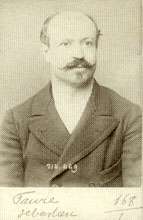Sébastien Faure

Sébastien Faure (born January 6, 1858 in Saint-Étienne, Loire, France; died July 14, 1942 in Royan, Charente-Maritime, France) was a French anarchist,[1] freethought and secularist activist and a principal proponent of synthesis anarchism.[2][3]
Biography
Before becoming a free-thinker, Faure was a seminarist. He engaged in politics as a socialist before turning to anarchism in 1888.
In 1894, he was prosecuted in "The Trial of the thirty" ("Procès des trente"), but was acquitted. In 1895, he cofounded "Le Libertaire" with Louise Michel, taking the name of the earlier journal by Joseph Déjacque. At the time of the Dreyfus affair, he was one of the leading supporters of Alfred Dreyfus. In 1904, he created a libertarian school called "La Ruche" (The Hive) close to Rambouillet. In 1916, he launched the periodical "Ce qu'il faut dire". Faure also co-founded (with Voline) the Synthesis, or also known as synthesis anarchism which was an influential form of conveiving anarchist federations.[4][5]
In 1918, he was imprisoned for organizing an illegal meeting. He is recognized for his pedagogy and his qualities as a speaker, and is the author of several books:
- The universal pain (1895)
- My Communism (1921)
- The Forces Of The Revolution (1921)
- Religious imposture (1923)
- Subversive remarks
- Twelve Proofs of God's Inexistence (1908)
He was also the founder of the Anarchist encyclopedia,[6] as well as the namesake of the Sébastien Faure Century, the French-speaking contingent of the Durruti Column during the civil war in Spain.
Synthesis anarchism
| Part of a series on |
| Anarchist communism |
|---|
 |
|
Concepts |
|
Organizational forms |
The discussion about the Anarchist Synthesis arises in the context of the discussion on the Organisational Platform of the Libertarian Communists, written by the Dielo Truda group of Russian exiles in 1926.[7]
Two texts made as responses to the Platform, each proposing a different organizational model, became the basis for what is known as the organisation of synthesis, or simply "synthesism".[8] Voline published in 1924 a paper calling for "the anarchist synthesis" and was also the author of the article in Sébastien Faure's Encyclopedie Anarchiste on the same topic.[9] The main purpose behind the synthesis was that the anarchist movement in most countries was divided into three main tendencies: communist anarchism, anarcho-syndicalism, and individualist anarchism[10] and so such an organization could contain anarchists of these 3 tendencies very well.
The platformists wanted to push their ideas forward through organizing an international anarchist congress on February 12, 1927.[11] Shortly later in the National Congress of the French Anarchist Union (UAF), the Dielo Truda Group achieved making their platform more popular and so they made the UAF change its name into Revolutionary Anarcho-Communist Union (UACR). Sébastien Faure led a faction within the UACR that decided to separate themselves from this organization and form outside it the Association of Federalist Anarchists (AFA), thinking that traditional anarchist ideas were being threatened by the Dielo Truda platform.[12] Shortly later in his text "Anarchist synthesis" he exposes the view that "these currents were not contradictory but complementary, each having a role within anarchism: anarcho-syndicalism as the strength of the mass organisations and the best way for the practice of anarchism; libertarian communism as a proposed future society based on the distribution of the fruits of labour according to the needs of each one; anarcho-individualism as a negation of oppression and affirming the individual right to development of the individual, seeking to please them in every way.[13] Sebastian Faure had strong contacts in Spain and so his proposal had more impact in spanish anarchists than the Dielo Truda platform even though individualist anarchist influence in Spain was less strong than it was in France. The main goal there was conciling anarcho-communism with anarcho-syndicalism.[14]
Views
Faure's view of pedagogy was that every single aspect of a human being had to be developed. Faure identified three aspects: physical, mental and moral. He thought that a man or a woman needed to be able to accomplish physical, manual tasks as well as to have a minimum of culture and think and be able to develop ideas. All this in a respectful, mutual, equal and free environment.
La Ruche
Created in 1904, the source of capital for La Ruche (The Hive) at the beginning was the product of Faure's seminars. It became self-sufficient in three years' time. Its founding principles were similar to Proudhon's Permanent Education and Paul Robin's "good birth, good education and good social organisation."
The three main spheres of pedagogy were fulfilled through classes, work in the field and all the different activities necessary to ensure the self-sufficiency of the Hive. The moral values were implemented through respect of the child's autonomy, positive method, absence of ranking or any form of categorization (except some activities were reserved to particular groups of age), coeducation, and sexual education (all activities being mixed.)
See also
Notes
- ↑ Gay, Kathlyn (1999). Encyclopedia of Political Anarchy. Santa Barbara: ABC-CLIO. p. 73. ISBN 0-87436-982-7.
- ↑ "Especifismo and Synthesis/ Synthesism" by Felipe Corrêa
- ↑ Jason Garner. "La búsqueda de la unidad anarquista: la Federación Anarquista Ibérica antes de la II República."
- ↑ "Especifismo and Synthesis/ Synthesism" by Felipe Corrêa
- ↑ Jason Garner. "La búsqueda de la unidad anarquista: la Federación Anarquista Ibérica antes de la II República."
- ↑ Graham, Robert (December 21, 2008). "Anarchy - Anarchist". Robert Graham's Anarchism Weblog. WordPress. Retrieved February 21, 2009.
- ↑ "Especifismo and Synthesis/ Synthesism" by Felipe Corrêa
- ↑ "Especifismo and Synthesis/ Synthesism" by Felipe Corrêa
- ↑ "J.3.2 What are "synthesis" federations?" in An Anarchist FAQ
- ↑ "J.3.2 What are "synthesis" federations?" in An Anarchist FAQ
- ↑ Jason Garner. "La búsqueda de la unidad anarquista: la Federación Anarquista Ibérica antes de la II República."
- ↑ "Tras la victoria de los plataformistas en el Congreso de París de 1929, una sección de los que consideraron que las ideas tradicionales del anarquismo estaban siendo atacadas se separó de la UACR para formar la Asociación de los Federalistas Anarquistas a comienzos de 192821. La principal figura de la AFA fue Sébastien Faure que, como respuesta a la Plataforma, expuso sus propuestas para un movimiento anarquista unificado en La síntesis anarquista, que apareció primero como un suplemento del informe de la AFA de febrero de 1928 titulado Le Trait d’Union Libertaire"Jason Garner. "La búsqueda de la unidad anarquista: la Federación Anarquista Ibérica antes de la II República."
- ↑ "Especifismo and Synthesis/ Synthesism" by Felipe Corrêa
- ↑ "Debido a sus contactos e influencia con el movimiento del exilio español, la propuesta de Faure arraigó más en los círculos españoles que la Plataforma, y fue publicada en las prensas libertarias tanto en España como en Bélgica25. En esencia, Faure intentaba reunir a la familia anarquista sin imponer la rígida estructura que proponía la Plataforma, y en España se aceptó así. Opuesta a la situación de Francia, en España la influencia del anarquismo individualista no fue un motivo serio de ruptura. Aunque las ideas de ciertos individualistas como Han Ryner y Émile Armand tuvieron cierto impacto sobre el anarquismo español, afectaron sólo a aspectos como el sexo y el amor libre."Jason Garner. "La búsqueda de la unidad anarquista: la Federación Anarquista Ibérica antes de la II República."
External links and references
| Wikimedia Commons has media related to Sébastien Faure. |
| Wikisource has original text related to this article: |
- Sébastien Faure page at the Daily Bleed's Anarchist Encyclopedia.
- The anarchist encyclopedia Volume 1 Volume 2 Volume 3 Volume 4
- Faure Archive at the Anarchy Archives.
- The Revolutionary Forces by Sebastien Faure
- Works by Sébastien Faure (public domain in Canada).
